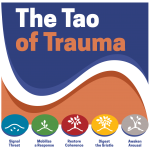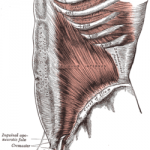The Earth Element has a special relationship with our muscles and flesh. The Spleen’s function to create qi is visible in the tone and capacity of our muscles. Our muscles carry body memories of our inner experiences. Thwarted mobilization responses, failures of self-protection, and untransformed traumatic experiences may be stored in them. What we believe and how we feel about these experiences may be found in our muscle memory and be reflected in our posture and stance toward life.
Our muscles tend to be loud and distracting in our interoceptive, body-awareness. They contain and convey strong sensations we are meant to feel—their tension or relaxation, their pain when we strain them, and their experience of weight and movement inform how we use them. Because they easily capture our attention with clear and available sensations, they can cloud more subtle information from other systems that may also need help.
Some clients will report only muscle-oriented information: “I have pain in my back and tension in my neck, and I feel stiff all over.” While we should attend to this information appropriately, we also need to remember that there are quieter and less easily accessible interoceptive indicators that can also inform our choice of interventions. Trauma survivors may miss more subtle and diffuse sensations of body awareness such as their digestion or heartbeat, which may be more important in restoring the self-protective response than their muscles. We need to stay attentive to these quieter signals and support our clients to develop their capacity to notice all aspects of their internal experience, not just the most vocal systems.
Check This Out!
 A year-long, integrative study of the Self Protective Response and the Five Elements of Acupuncture and Asian Medicine. Learn interaction, observation and touch skills to augment work with trauma survivors.
A year-long, integrative study of the Self Protective Response and the Five Elements of Acupuncture and Asian Medicine. Learn interaction, observation and touch skills to augment work with trauma survivors.
Acupuncturists, Somatic Experiencing Practitioners, Intermediate SE students, and providers with equivalent training are welcome to register.
60 CEU’s for relevant providers.
January 26 & 27 – Signaling Threat
March 23 & 24 – Mobilizing A Response
June 8 & 9 – Restoring Coherence
September 14 & 15 – Digesting The Gristle
November 2 & 3 – Awakening Arousal
Clinical Curiosity
Q. I treat my client in her Earth. Her main complaint is back pain. I’m able to use points on her lower legs — but she won’t let me get near the location of her pain, which is in her low to mid back. Sometimes it feels like she wants sympathy for her pain more than she wants to get well.
A. I wonder if her pain is near the juncture of her thoracic and lumbar vertebrae, just above her waist? The last thoracic, T-12, is a really interesting bone. Its upper half is shaped like a thoracic — and designed for twisting and turning, and its lower half is shaped like a lumbar, designed for stability. Inherent in its structure is the dilemma many survivors faced once upon a time: “Do I turn and run, or do I stand my ground and fight – which will it be, “fight or flight”? The tension inherent in this question, and this bone, makes it the vertebrae most likely to be broken in the whole spinal column.
 This area is also the location of the powerful back shu points of the Spleen and Stomach, the origin of the psoas muscle, and the location where the respiratory diaphragm connects at the back. Very high arousal states may reside in any of these structures because of their inherent roles in the Self Protective Response.
This area is also the location of the powerful back shu points of the Spleen and Stomach, the origin of the psoas muscle, and the location where the respiratory diaphragm connects at the back. Very high arousal states may reside in any of these structures because of their inherent roles in the Self Protective Response.
It may be too challenging for her physiology to accept a needle here. Try starting with her lying on her back, and sliding your hand under the area. Bring your sympathetic attention to the pain, tightness, or bracing she is experiencing. She may be able to let go of her bracing bit by bit and allow your sympathy to nourish her. Over time she will be able to welcome more direct interventions to the area.

